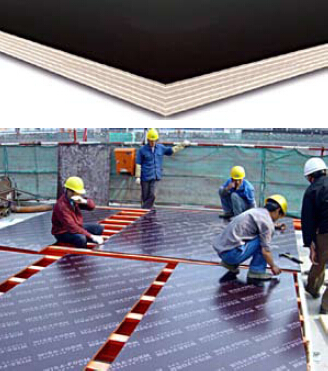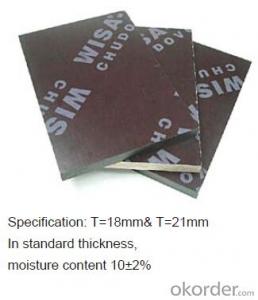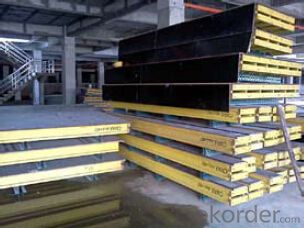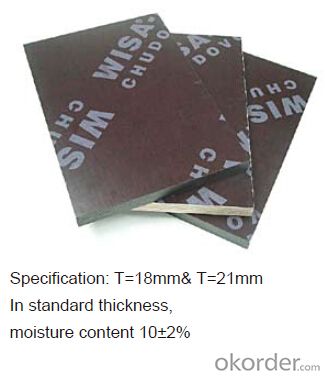Plywood-formwork Systems for Formwork and Scaffolding
- Loading Port:
- Tianjin
- Payment Terms:
- TT OR LC
- Min Order Qty:
- 50 m²
- Supply Capability:
- 1000 m²/month
OKorder Service Pledge
Quality Product, Order Online Tracking, Timely Delivery
OKorder Financial Service
Credit Rating, Credit Services, Credit Purchasing
You Might Also Like
Plywood --- make perfect concrete surface
WISA-Form Birch is a coated special plywood using in the formwork systems where high
requirements are set on the concrete surface and the times of reuses.
With CNBM timber beam & WISA plywood, the formwork is low weight but high load capacity, it is
widely used in construction.
Characteristics:
◆ Component with high standardization.
◆ Assembling in site, flexible application.
◆ Light weight, easy transportation and storage.


- Q: How does steel formwork handle concrete pump pressure?
- Steel formwork is highly durable and strong, allowing it to effectively handle concrete pump pressure. Its robust structure and rigidity help distribute and withstand the force exerted by the concrete pump, ensuring that the formwork maintains its shape and integrity during the pouring process. This enables the steel formwork to effectively contain and support the concrete, resulting in a successfully executed construction project.
- Q: Can steel formwork be used for fire-resistant concrete structures?
- No, steel formwork cannot be used for fire-resistant concrete structures. Steel is highly susceptible to heat and can lose its structural integrity when exposed to high temperatures, thus compromising the fire resistance of the concrete structure. Fire-resistant concrete structures require specialized forms made of non-combustible materials, such as fire-rated plywood or fiber-reinforced plastic, which can withstand extreme heat and maintain the integrity of the structure during a fire.
- Q: Is steel formwork easy to assemble and disassemble?
- Yes, steel formwork is relatively easy to assemble and disassemble compared to other types of formwork systems. Steel formwork consists of prefabricated panels that can be easily connected and secured together using various methods such as clamps, pins, or wedges. The panels are typically lightweight and come in standardized sizes, making them easy to handle and transport. Moreover, steel formwork offers the advantage of being adjustable and reusable. The panels can be easily adjusted to different dimensions and shapes by using adjustable screws or other mechanisms, allowing for flexibility in construction projects. Additionally, steel formwork can be used multiple times, significantly reducing the cost and time needed for formwork installation on subsequent projects. The disassembly process of steel formwork is also relatively simple. Once the concrete has cured, the panels can be easily removed by releasing the connecting mechanisms and dismantling the formwork system. The lightweight nature of steel formwork panels makes the handling and removal process easier and less labor-intensive compared to heavier formwork materials such as timber or plywood. Overall, the ease of assembly and disassembly of steel formwork makes it a preferred choice for many construction projects, especially those requiring repetitive use and quick turnaround times.
- Q: What are the different types of steel formwork available?
- There are several types of steel formwork available in the construction industry, each with its own unique features and advantages. Some of the most common types include: 1. Modular steel formwork: This type of formwork consists of prefabricated steel panels that can be assembled and disassembled easily. It is customizable and can be used for various shapes and sizes of concrete structures. 2. Tunnel formwork: As the name suggests, tunnel formwork is used for constructing tunnels and underground structures. It is made of steel plates and is designed to withstand high pressure and provide a smooth finish to the concrete. 3. Climbing formwork: This type of formwork is used for tall structures like skyscrapers. It is designed to be lifted and moved vertically as the construction progresses. Climbing formwork provides safety and efficiency while constructing multi-story buildings. 4. Steel soldier formwork: This is a versatile and cost-effective type of formwork that is commonly used for walls and columns. It is made of steel beams and soldiers and can be easily adjusted to different heights and widths. 5. Steel frame formwork: This type of formwork is made of steel frames with plywood or metal panels attached to it. It is lightweight, easy to handle, and provides a smooth finish to the concrete. 6. Steel table formwork: This is a type of formwork that is used for large horizontal slabs. It consists of steel tables that are supported by props or scaffolding. Steel table formwork is quick to assemble and dismantle, making it ideal for projects with tight timelines. These are just a few examples of the different types of steel formwork available. The choice of formwork depends on the specific requirements of the construction project, such as the type of structure, load-bearing capacity, and desired finish.
- Q: How does steel formwork affect the overall sustainability of a concrete structure?
- The overall sustainability of a concrete structure can be significantly influenced by steel formwork. To begin with, the reusability of steel formwork allows for its utilization in multiple construction projects, thereby reducing the need for additional materials and minimizing waste. This reusability also aids in decreasing the environmental impact associated with the production and disposal of formwork materials. Furthermore, the durability and robustness of steel formwork ensure that it can endure repeated use without compromising its structural integrity. This durability extends the lifespan of the formwork, resulting in fewer replacements and less waste generation. Additionally, steel formwork provides superior strength and stability, enabling the construction of concrete structures with greater precision and efficiency. This allows for the use of less concrete, thereby reducing the overall carbon footprint of the structure. Moreover, the utilization of steel formwork can lead to quicker construction times, which in turn reduces energy consumption and minimizes the project's environmental impact. Moreover, steel formwork allows for greater flexibility in design and construction techniques, thus enabling the development of more sustainable structures. It can be easily customized to fit various shapes and sizes, optimizing space usage and reducing material wastage. This flexibility also allows for the incorporation of sustainable features such as energy-efficient insulation, green roofs, or rainwater harvesting systems. In conclusion, steel formwork positively influences the overall sustainability of a concrete structure through its reusability, durability, strength, and flexibility. By reducing waste generation, minimizing the use of concrete, and enabling sustainable design options, steel formwork contributes to the creation of more environmentally-friendly and efficient structures.
- Q: What are the considerations when designing steel formwork for underground parking structures?
- When designing steel formwork for underground parking structures, there are several important considerations that need to be taken into account. These considerations include: 1. Structural Stability: Underground parking structures experience significant loads from the surrounding soil, as well as the weight of the vehicles they will accommodate. It is crucial to design the steel formwork in a way that ensures structural stability and can withstand these loads. 2. Water Resistance: Underground parking structures are susceptible to water infiltration, especially in areas with high groundwater levels. The steel formwork should be designed to be watertight, with proper sealing and waterproofing measures in place, to prevent water damage and maintain the integrity of the structure. 3. Fire Resistance: Fire safety is of utmost importance in underground parking structures. The steel formwork should be designed to meet the required fire resistance standards and provide adequate protection against fire hazards. 4. Durability: Underground parking structures are subject to constant traffic and wear and tear. The steel formwork should be designed to be durable and able to withstand the load and stress imposed by vehicles, as well as any potential impact from collisions or accidents. 5. Accessibility and Efficiency: The design of the steel formwork should take into consideration the accessibility of the parking structure, including the layout of ramps, entrances, and exits. It should also aim to maximize space utilization and efficiency, providing adequate parking slots without compromising safety or ease of use. 6. Maintenance and Repairs: The design should also consider the ease of maintenance and repairs. Accessible areas for inspection, maintenance, and repairs should be incorporated into the formwork design to ensure that any necessary maintenance or repairs can be carried out efficiently. 7. Cost-effectiveness: Finally, the design should strike a balance between meeting all the necessary requirements and being cost-effective. It is essential to consider the overall cost of materials, construction, and maintenance when designing the steel formwork for underground parking structures. By carefully considering these considerations, engineers and designers can create effective and efficient steel formwork for underground parking structures that meet all the necessary requirements for safety, durability, and functionality.
- Q: Is steel formwork suitable for all types of concrete structures?
- Steel formwork is generally considered to be suitable for a wide range of concrete structures. However, its suitability may depend on several factors such as the design requirements, budget, and project timeline. Steel formwork offers several advantages over other types of formwork systems. It is known for its high strength and durability, which allows it to withstand the pressure exerted by the fresh concrete without warping or deforming. This makes it particularly suitable for structures that require large concrete pours or have complex geometries. Moreover, steel formwork provides excellent dimensional accuracy, ensuring that the final concrete structure meets the required specifications. It also allows for easy customization, enabling the formwork to be tailored to the specific needs of the project. However, there are instances where steel formwork may not be the most suitable option. For example, if the budget is limited, steel formwork may be more expensive compared to alternatives such as timber or plastic formwork. Additionally, if the project has a tight schedule, steel formwork may require more time for fabrication and assembly compared to other systems. Furthermore, steel formwork may not be the best choice for structures that have strict aesthetic requirements. The steel panels may leave imprints on the concrete surface, which may not be desirable in certain architectural designs. In conclusion, while steel formwork is generally suitable for a wide range of concrete structures, its suitability may vary based on project-specific factors such as design requirements, budget, and timeline. It is important to carefully evaluate these factors before deciding on the most appropriate formwork system for a particular project.
- Q: Can steel formwork be used for both flat and sloped surfaces?
- Yes, steel formwork can be used for both flat and sloped surfaces. Steel formwork is a versatile and durable option for construction projects and can be easily adapted to form structures with various slopes. The flexibility of steel allows it to be bent or shaped to the desired angle, making it suitable for creating formwork for sloped surfaces. Additionally, steel formwork provides excellent support and stability, ensuring that the concrete is poured accurately and evenly on both flat and sloped surfaces. Its strength and rigidity make it a reliable choice for constructing formwork systems that can withstand the pressures exerted by the concrete during the casting process, regardless of the surface slope.
- Q: Can steel formwork be used for precast concrete columns?
- Yes, steel formwork can be used for precast concrete columns. Steel formwork offers durability and strength, making it suitable for creating precise and complex shapes required for precast concrete columns. Additionally, steel formwork can be reused multiple times, making it a cost-effective option for precast concrete column production.
- Q: Can steel formwork be used for both interior and exterior concrete structures?
- Yes, steel formwork can be used for both interior and exterior concrete structures. Steel formwork provides durability, strength, and stability, making it suitable for various construction projects, regardless of the location or environment.
Send your message to us
Plywood-formwork Systems for Formwork and Scaffolding
- Loading Port:
- Tianjin
- Payment Terms:
- TT OR LC
- Min Order Qty:
- 50 m²
- Supply Capability:
- 1000 m²/month
OKorder Service Pledge
Quality Product, Order Online Tracking, Timely Delivery
OKorder Financial Service
Credit Rating, Credit Services, Credit Purchasing
Similar products
Hot products
Hot Searches
Related keywords



















